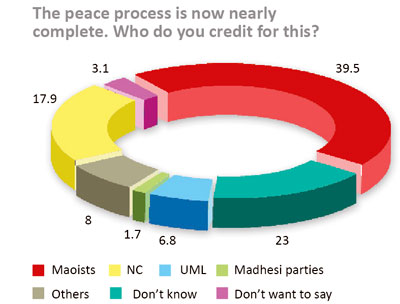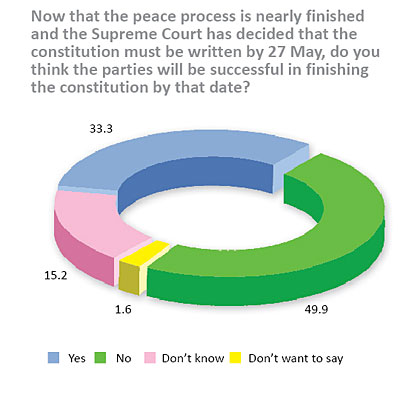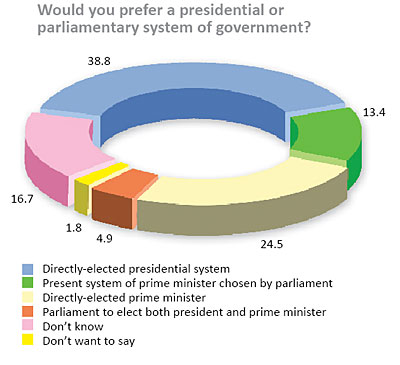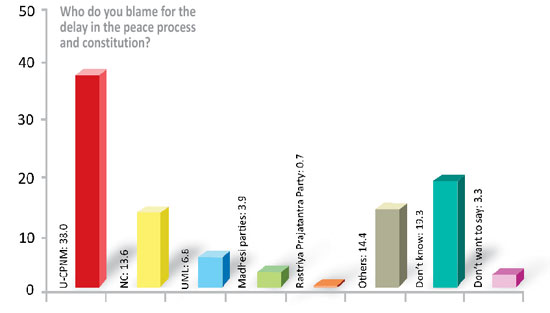 |
 |
This year's poll is no different. The Himalmedia Public Opinion Survey 2012 shows that inflation remains the number one preoccupation of the people with 92% saying it is worse than last year, and 64% saying corruption is worse. Politics is way down in their list of concerns, and the constitution is important only in as much as it has a bearing on peace. But a majority of respondents still feel things are improving, and 85% of those in the Himal and Pahad cite road access as the biggest progress.
 |
Disaggregating the data, however, shows a stark difference in the perception of development in the Tarai where half the respondents said there has been little development. Interestingly, those who can't read or write seem happier, and the more educated the respondents the more dissatisfied they seem to be with the pace of development.
Nepalis seem disillusioned with a Westminster-style parliamentary democracy and want direct franchise to elect future executive presidents or prime ministers. Asked which form of government they would prefer, nearly 40% favoured a directly-elected presidential system, and 25% wanted to vote directly for prime ministers.
The most dramatic change this year compared to the last few polls has been in the perception of top political personalities. Most respondents give credit to Baburam Bhattarai and Pushpa Kamal Dahal (37% and 20% respectively) for concluding the peace process.
When asked who they would directly vote for as executive prime minister or president, Bhattarai topped the list of names of 12 senior leaders from four parties with a 30.6% approval rating. Pushpa Kamal Dahal trailed with 8.6%, and President Ram Baran Yadav ranked second with 10.4% of votes. The Baidya faction was nowhere in the picture, and all other leaders of the NC, UML and Madhesis were in the single digits, or even below 1%. Surprisingly, even though his name was not on the list, many said they would vote for Gagan Thapa. But the popularity contest is still up for grabs because one-third of the respondents said they didn't know or didn't want to say.
 |
In a surprising departure from these results, when asked to rank the parties they trusted the most to take Nepal forward towards peace and prosperity, the Nepali Congress pipped the Maoists with 66% versus 63% and the UML got 61%. Nearly 20 percent didn't have a preference. Contrary to popular belief, there seems to be scant correlation between support for the Maoist party and age, gender, ethnicity. Support for other parties among young people and ethnic groups was more or less even.
 |
 |
On the most contentious issues in the new constitution, there is a clear majority against demarcating future federal units along ethnic lines. A full 73% of the respondents rejected ethnicity-based federal units and only 14% were undecided. Last year, 76% had said no to ethnic federalism. Interestingly, like last year, 64% of hill ethnic respondents, 70% of Newars and 57% of Madhesi ethnics (which include the Tharus) didn't want federal units for ethnic groups.
Asked what would be an alternative model for federal units, 45% favoured north-south territorial units that include Himal, Pahad and Tarai and the proportion of people who support this are equal in all three regions. Thirty per cent wanted the current zones to be simply converted into federal units.
 |
Himalmedia Polls
Himalmedia has been conducting public opinion polls nearly every year since 2000 to gauge the public pulse. Over the years, in monarchy or republic, war or peace, the surveys have served as important barometers of Nepali people's regard (or disregard) for their rulers, the relative popularity of political parties, and recorded the main concerns of the people.
Past polls have accurately predicted the results of elections, and served as rough referenda on the rise and fall of political personalities. Which must be why they have often been criticised as being biased or unscientific by leaders who do not fare well. But when they do better in the surveys than their rivals, the same parties have held up survey results to prove their popularity.
Former king Gyanendra once scoffed at public opinion polls, saying they served no purpose in a country like Nepal, only to lose his throne soon after. Pushpa Kamal Dahal, who has always done well in opinion surveys (except this year) famously boasted after the 2009 survey: "Even a media house that has always been critical of our party has said I am the leader the people trust the most."
This year's Himalmedia Public Opinion Survey was based on interviews with 3,210 respondents in 38 districts selected through a non-random sampling method in April. More than 60 enumerators fanned out across the country to select respondents between the ages of 18-60, and asked 39 questions during the week of 22-29 April.
Compared to the 2011 survey, enumerators felt respondents were even less hesitant to answer interview questions, volunteering their names and phone numbers. In one case, when an enumerator had misplaced her pen and was ticking off boxes with a pencil, a respondent insisted that she use a pen. The full disaggregated tabulation of the poll is available.
Read also:
Voters' voice
More things change more they stay the same
The times they are changing, ANURAG ACHARYA


